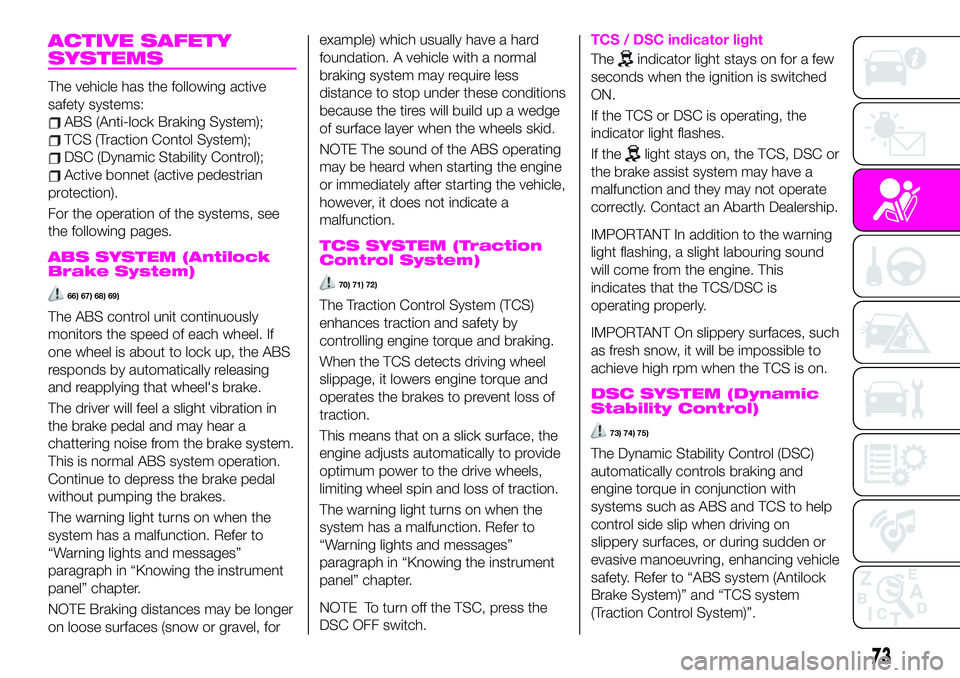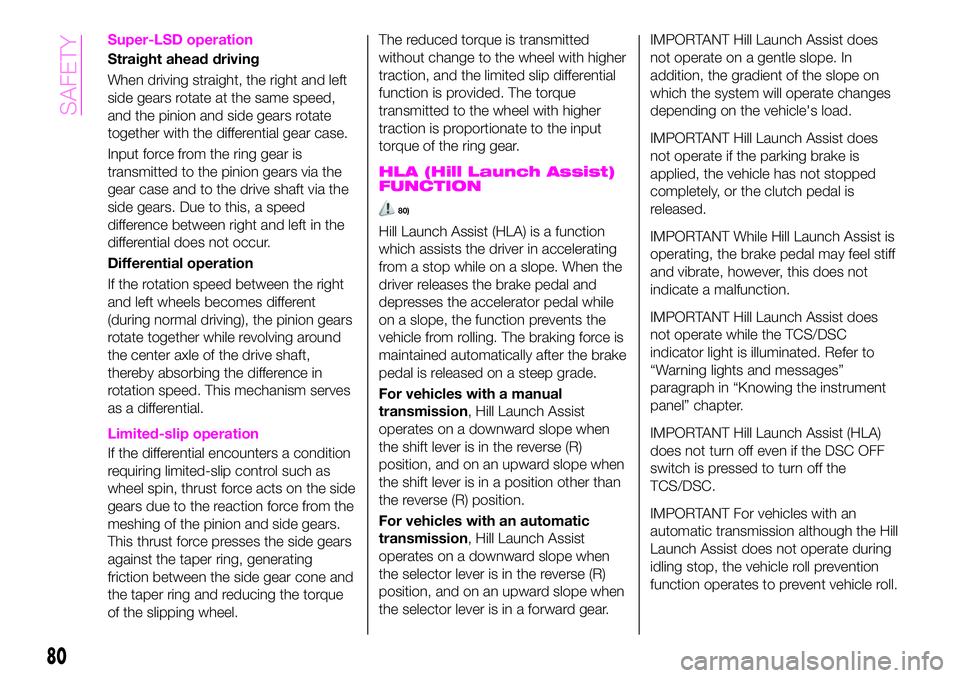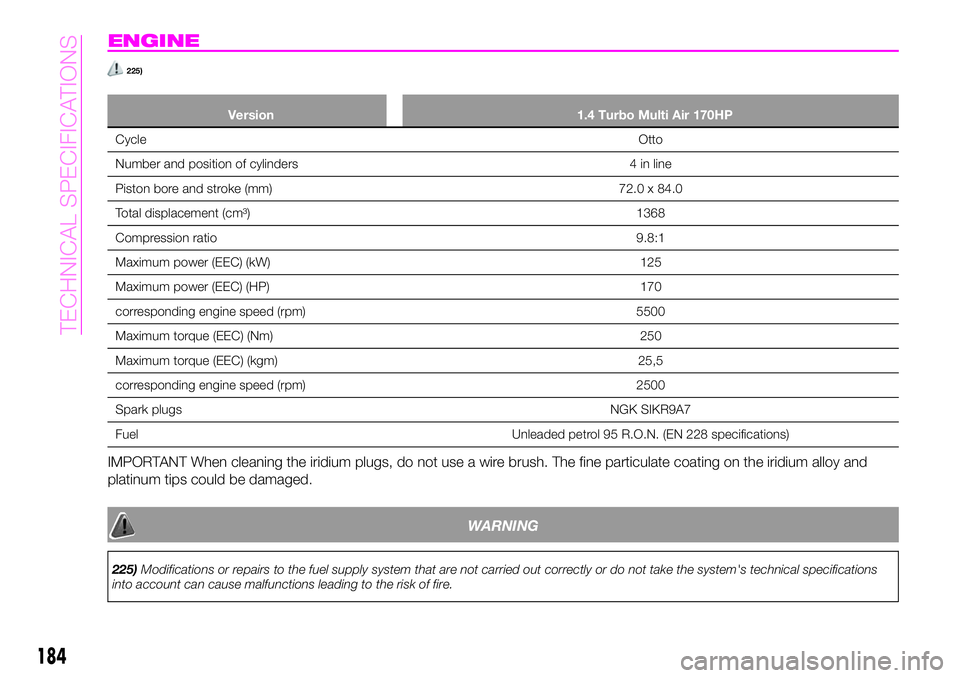torque Abarth 124 Spider 2020 Owner handbook (in English)
[x] Cancel search | Manufacturer: ABARTH, Model Year: 2020, Model line: 124 Spider, Model: Abarth 124 Spider 2020Pages: 224, PDF Size: 3.9 MB
Page 75 of 224

ACTIVE SAFETY
SYSTEMS
The vehicle has the following active
safety systems:
ABS (Anti-lock Braking System);
TCS (Traction Contol System);
DSC (Dynamic Stability Control);
Active bonnet (active pedestrian
protection).
For the operation of the systems, see
the following pages.
ABS SYSTEM (Antilock
Brake System)
66) 67) 68) 69)
The ABS control unit continuously
monitors the speed of each wheel. If
one wheel is about to lock up, the ABS
responds by automatically releasing
and reapplying that wheel's brake.
The driver will feel a slight vibration in
the brake pedal and may hear a
chattering noise from the brake system.
This is normal ABS system operation.
Continue to depress the brake pedal
without pumping the brakes.
The warning light turns on when the
system has a malfunction. Refer to
“Warning lights and messages”
paragraph in “Knowing the instrument
panel” chapter.
NOTE Braking distances may be longer
on loose surfaces (snow or gravel, forexample) which usually have a hard
foundation. A vehicle with a normal
braking system may require less
distance to stop under these conditions
because the tires will build up a wedge
of surface layer when the wheels skid.
NOTE The sound of the ABS operating
may be heard when starting the engine
or immediately after starting the vehicle,
however, it does not indicate a
malfunction.
TCS SYSTEM (Traction
Control System)
70) 71) 72)
The Traction Control System (TCS)
enhances traction and safety by
controlling engine torque and braking.
When the TCS detects driving wheel
slippage, it lowers engine torque and
operates the brakes to prevent loss of
traction.
This means that on a slick surface, the
engine adjusts automatically to provide
optimum power to the drive wheels,
limiting wheel spin and loss of traction.
The warning light turns on when the
system has a malfunction. Refer to
“Warning lights and messages”
paragraph in “Knowing the instrument
panel” chapter.
NOTE To turn off the TSC, press the
DSC OFF switch.
TCS / DSC indicator light
Theindicator light stays on for a few
seconds when the ignition is switched
ON.
If the TCS or DSC is operating, the
indicator light flashes.
If the
light stays on, the TCS, DSC or
the brake assist system may have a
malfunction and they may not operate
correctly. Contact an Abarth Dealership.
IMPORTANT In addition to the warning
light flashing, a slight labouring sound
will come from the engine. This
indicates that the TCS/DSC is
operating properly.
IMPORTANT On slippery surfaces, such
as fresh snow, it will be impossible to
achieve high rpm when the TCS is on.
DSC SYSTEM (Dynamic
Stability Control)
73) 74) 75)
The Dynamic Stability Control (DSC)
automatically controls braking and
engine torque in conjunction with
systems such as ABS and TCS to help
control side slip when driving on
slippery surfaces, or during sudden or
evasive manoeuvring, enhancing vehicle
safety. Refer to “ABS system (Antilock
Brake System)” and “TCS system
(Traction Control System)”.
73
Page 81 of 224

When changing tires yourself:ifyou
or someone else changes tires, you or
someone else can also undertake the
steps for the TPMS to complete the ID
signal code registration:
after tires have been changed, switch
the ignition ON, then back to ACC or
OFF;
wait for about 15 minutes;
after about 15 minutes, drive the
vehicle at a speed of at least 25 km/h
for 10 minutes and the tire pressure
sensor ID signal code will be registered
automatically.
IMPORTANT If the vehicle is driven
within about 15 minutes of changing
tires, the
warning light will flash
because the sensor ID signal code
would not have been registered. If this
happens, park the vehicle for about
15 minutes, after which the sensor ID
signal code will register upon driving the
vehicle for 10 minutes.
Replacing tires and wheels
IMPORTANT When replacing/repairing
the tires or wheels or both, have the
work done by an Abarth Dealership, or
the tire pressure sensors may be
damaged.
IMPORTANT The wheels equipped on
your vehicle are specially designed for
installation of the tire pressure sensors.Do not use non-genuine wheels,
otherwise it may not be possible to
install the tire pressure sensors.
Be sure to have the tire pressure
sensors installed whenever tires or
wheels are replaced.
When having a tire or wheel or both
replaced, the following types of tire
pressure sensor installations are
possible:
the tire pressure sensor is removed
from the old wheel and installed to the
new one;
the same tire pressure sensor is used
with the same wheel. Only the tire is
replaced;
a new tire pressure sensor is installed
to a new wheel.
IMPORTANT The tire pressure sensor
ID signal code must be registered when
a new tire pressure sensor is
purchased. For purchase of a tire
pressure sensor and registration of the
tire pressure sensor ID signal code,
consult an Abarth Dealership.
IMPORTANT When reinstalling a
previously removed tire pressure sensor
to a wheel, replace the grommet (seal
between valve body/sensor and wheel)
for the tire pressure sensor.
MECHANICAL LIMITED
SLIP DIFFERENTIAL
Your vehicle is equipped with a
mechanical limited slip differential. In
particular this vehicle adopts a
super-LSD which guarantees improved
vehicle traction and handling.
A super-LSD with a low torque bias
ratio (*) has been adopted to improve
performance when starting from a
standstill, driving straight-ahead and
response.
(*)Torque bias ratio: when a wheel
slips due to a low-traction surface, the
LSD provides proportionally more
torque to the opposite wheel. The
torque bias ratio is the ratio of torque
supplied to the right and left wheels in
such cases, and represents the
performance capability of the LSD.
The super-LSD is a torque-sensing type
that provides improved driving stability
due to the following characteristics:
low torque bias ratio provides
improved controllability (torque bias
ratio: 2.0);
creation of initial torque provides
improved starting from a standstill and
acceleration/deceleration response, and
driving straight-ahead (initial torque:
49 Nm);
simplified construction provides
weight reduction.
79
Page 82 of 224

Super-LSD operation
Straight ahead driving
When driving straight, the right and left
side gears rotate at the same speed,
and the pinion and side gears rotate
together with the differential gear case.
Input force from the ring gear is
transmitted to the pinion gears via the
gear case and to the drive shaft via the
side gears. Due to this, a speed
difference between right and left in the
differential does not occur.
Differential operation
If the rotation speed between the right
and left wheels becomes different
(during normal driving), the pinion gears
rotate together while revolving around
the center axle of the drive shaft,
thereby absorbing the difference in
rotation speed. This mechanism serves
as a differential.
Limited-slip operation
If the differential encounters a condition
requiring limited-slip control such as
wheel spin, thrust force acts on the side
gears due to the reaction force from the
meshing of the pinion and side gears.
This thrust force presses the side gears
against the taper ring, generating
friction between the side gear cone and
the taper ring and reducing the torque
of the slipping wheel.The reduced torque is transmitted
without change to the wheel with higher
traction, and the limited slip differential
function is provided. The torque
transmitted to the wheel with higher
traction is proportionate to the input
torque of the ring gear.
HLA (Hill Launch Assist)
FUNCTION
80)
Hill Launch Assist (HLA) is a function
which assists the driver in accelerating
from a stop while on a slope. When the
driver releases the brake pedal and
depresses the accelerator pedal while
on a slope, the function prevents the
vehicle from rolling. The braking force is
maintained automatically after the brake
pedal is released on a steep grade.
For vehicles with a manual
transmission, Hill Launch Assist
operates on a downward slope when
the shift lever is in the reverse (R)
position, and on an upward slope when
the shift lever is in a position other than
the reverse (R) position.
For vehicles with an automatic
transmission, Hill Launch Assist
operates on a downward slope when
the selector lever is in the reverse (R)
position, and on an upward slope when
the selector lever is in a forward gear.
IMPORTANT Hill Launch Assist does
not operate on a gentle slope. In
addition, the gradient of the slope on
which the system will operate changes
depending on the vehicle's load.
IMPORTANT Hill Launch Assist does
not operate if the parking brake is
applied, the vehicle has not stopped
completely, or the clutch pedal is
released.
IMPORTANT While Hill Launch Assist is
operating, the brake pedal may feel stiff
and vibrate, however, this does not
indicate a malfunction.
IMPORTANT Hill Launch Assist does
not operate while the TCS/DSC
indicator light is illuminated. Refer to
“Warning lights and messages”
paragraph in “Knowing the instrument
panel” chapter.
IMPORTANT Hill Launch Assist (HLA)
does not turn off even if the DSC OFF
switch is pressed to turn off the
TCS/DSC.
IMPORTANT For vehicles with an
automatic transmission although the Hill
Launch Assist does not operate during
idling stop, the vehicle roll prevention
function operates to prevent vehicle roll.
80
SAFETY
Page 186 of 224

ENGINE
225)
Version 1.4 Turbo Multi Air 170HP
CycleOtto
Number and position of cylinders 4 in line
Piston bore and stroke (mm) 72.0 x 84.0
Total displacement (cm³) 1368
Compression ratio9.8:1
Maximum power (EEC) (kW) 125
Maximum power (EEC) (HP) 170
corresponding engine speed (rpm) 5500
Maximum torque (EEC) (Nm) 250
Maximum torque (EEC) (kgm) 25,5
corresponding engine speed (rpm) 2500
Spark plugsNGK SIKR9A7
Fuel Unleaded petrol 95 R.O.N. (EN 228 specifications)
IMPORTANT When cleaning the iridium plugs, do not use a wire brush. The fine particulate coating on the iridium alloy and
platinum tips could be damaged.
WARNING
225)Modifications or repairs to the fuel supply system that are not carried out correctly or do not take the system's technical specifications
into account can cause malfunctions leading to the risk of fire.
184
TECHNICAL SPECIFICATIONS